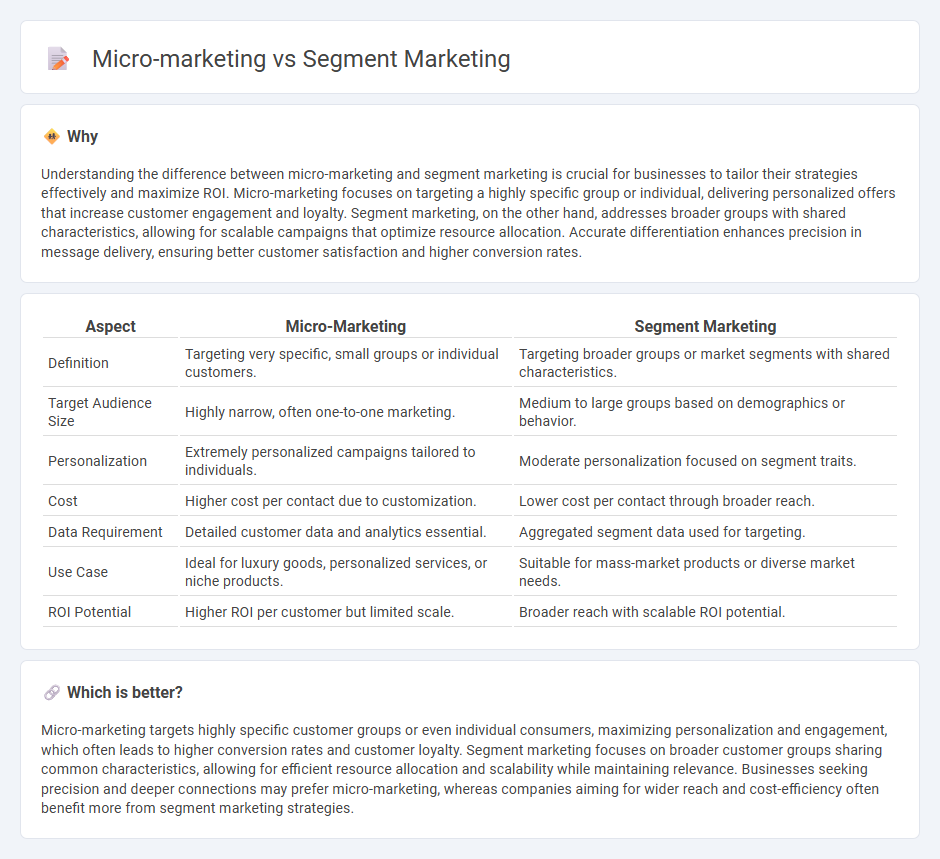
Micro-marketing targets highly specific customer groups or even individuals, tailoring sales strategies to unique preferences and behaviors, leading to increased conversion rates and customer loyalty. Segment marketing divides the broader market into distinct groups based on demographics, psychographics, or behavior, allowing for more efficient resource allocation and focused messaging. Explore how these marketing approaches can boost your sales performance.
Why it is important
Understanding the difference between micro-marketing and segment marketing is crucial for businesses to tailor their strategies effectively and maximize ROI. Micro-marketing focuses on targeting a highly specific group or individual, delivering personalized offers that increase customer engagement and loyalty. Segment marketing, on the other hand, addresses broader groups with shared characteristics, allowing for scalable campaigns that optimize resource allocation. Accurate differentiation enhances precision in message delivery, ensuring better customer satisfaction and higher conversion rates.
Comparison Table
| Aspect | Micro-Marketing | Segment Marketing |
|---|---|---|
| Definition | Targeting very specific, small groups or individual customers. | Targeting broader groups or market segments with shared characteristics. |
| Target Audience Size | Highly narrow, often one-to-one marketing. | Medium to large groups based on demographics or behavior. |
| Personalization | Extremely personalized campaigns tailored to individuals. | Moderate personalization focused on segment traits. |
| Cost | Higher cost per contact due to customization. | Lower cost per contact through broader reach. |
| Data Requirement | Detailed customer data and analytics essential. | Aggregated segment data used for targeting. |
| Use Case | Ideal for luxury goods, personalized services, or niche products. | Suitable for mass-market products or diverse market needs. |
| ROI Potential | Higher ROI per customer but limited scale. | Broader reach with scalable ROI potential. |
Which is better?
Micro-marketing targets highly specific customer groups or even individual consumers, maximizing personalization and engagement, which often leads to higher conversion rates and customer loyalty. Segment marketing focuses on broader customer groups sharing common characteristics, allowing for efficient resource allocation and scalability while maintaining relevance. Businesses seeking precision and deeper connections may prefer micro-marketing, whereas companies aiming for wider reach and cost-efficiency often benefit more from segment marketing strategies.
Connection
Micro-marketing and segment marketing are connected through their targeted approach to reaching specific consumer groups within a larger market. Segment marketing divides the market into distinct subsets based on demographics, behaviors, or preferences, while micro-marketing focuses on tailoring strategies to even narrower, localized groups or individual customers within those segments. Both methods optimize sales by delivering personalized messages and offers that increase relevance and customer engagement.
Key Terms
Target Audience
Segment marketing targets broad groups defined by shared characteristics such as demographics, behaviors, or geographic location, enabling tailored messaging that resonates with larger, specific audiences. Micro-marketing narrows this focus further, addressing highly specific, niche groups or even individual customers with personalized offers and content to maximize engagement and conversion. Explore how these strategies can be leveraged to optimize your marketing impact.
Personalization
Segment marketing targets specific groups defined by shared characteristics such as demographics or behavior, leveraging data to tailor campaigns that resonate with broader audience clusters. Micro-marketing drills down to individual customers or hyper-local groups, emphasizing personalization through detailed consumer insights and customized messaging to enhance engagement. Explore deeper strategies to optimize your marketing efforts by understanding the nuances between segment marketing and micro-marketing.
Market Size
Segment marketing targets broader groups within a market based on shared characteristics, optimizing strategies for sizable customer segments typically ranging from thousands to millions. Micro-marketing hones in on highly specific niches or individual customers, often focusing on small groups or even one-on-one interactions to tailor personalized offerings. Explore further to understand how market size influences the effectiveness of these marketing approaches.
Source and External Links
What is Market Segmentation? A Guide | Salesforce US - Market segmentation divides a broader target market into smaller groups based on shared attributes to tailor marketing efforts, enhance personalization, and optimize budgets by targeting high-potential audience segments with relevant messages and product features.
Market segmentation - Wikipedia - Market segmentation is the process of dividing a market into meaningful sub-groups (segments) according to common characteristics to identify profitable segments for targeted marketing strategies using the Segmentation - Targeting - Positioning (S-T-P) framework.
Market segments -- what they are, how they work, and how to use ... - A market segment consists of consumers who share similar needs or characteristics and respond similarly to marketing; identifying these segments allows companies to tailor marketing strategies, enhance brand loyalty, and increase profitability by meeting each segment's unique preferences.
 dowidth.com
dowidth.com